#RPM Motorsports
Explore tagged Tumblr posts
Text
1969 Lola T70 🔥❤️
engine: Chevrolet 90º V8
displacement: 4995 cc / 304.81 in³
power: 335.6 kw / 450 bhp @ 7000 rpm.
It could reach a top speed of 200 mph on the Mulsanne straight.
🇬🇧 #Motorsport
24 notes
·
View notes
Text


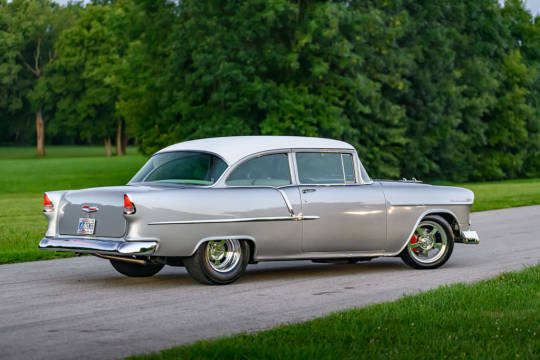
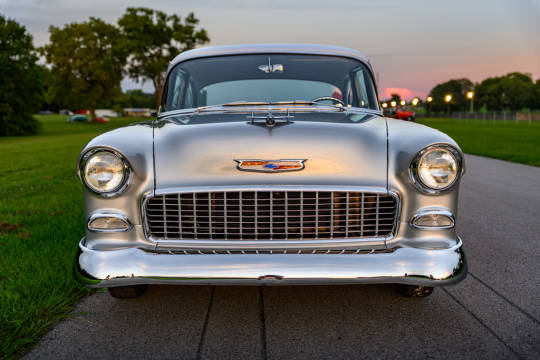
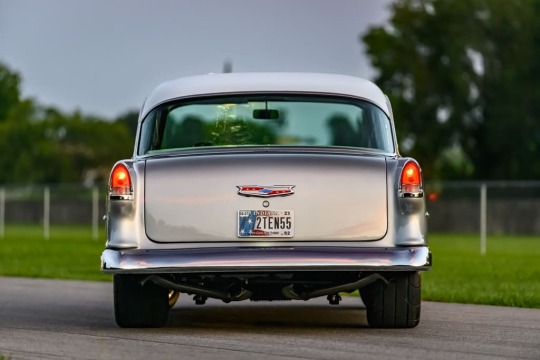
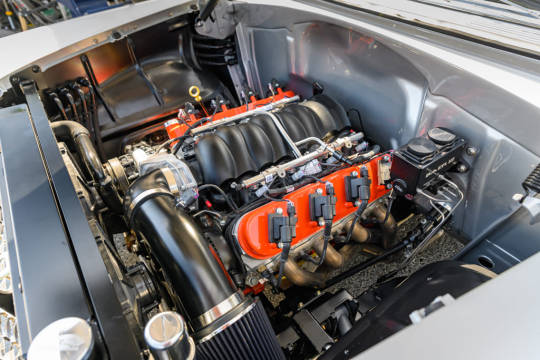
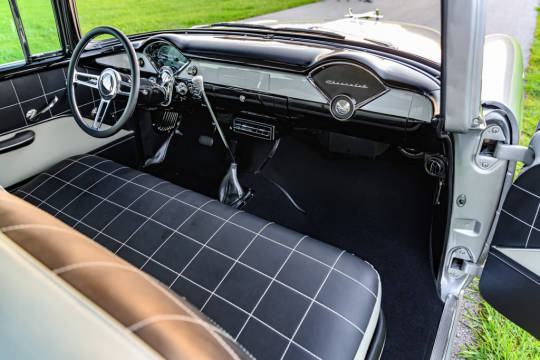
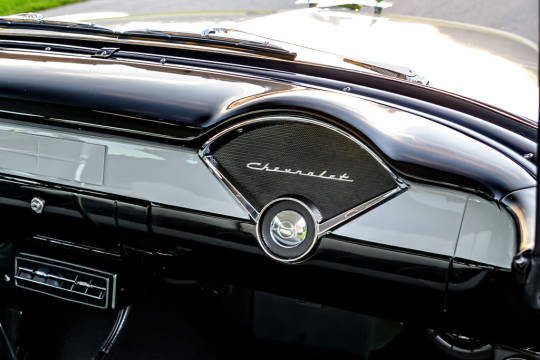
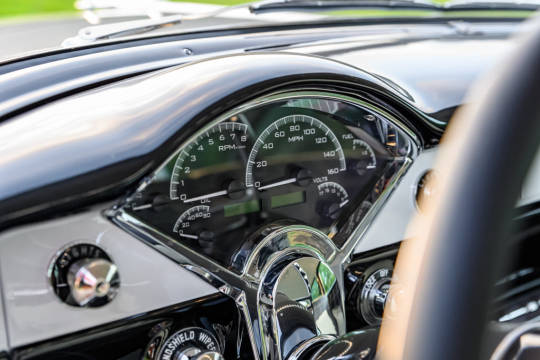


1955 Chevrolet 210
TECH CHECK Owner: Eric Mead, Evansville, Indiana Vehicle: ’55 Chevrolet 210
Engine Type: BluePrint Engines Chevrolet LS3 Displacement: 376 ci Compression Ratio: 10.7:1 Bore: 4.070 inches Stroke: 3.622 inches Cylinder Heads: BluePrint Engines aluminum Camshaft: BluePrint Engines hydraulic roller (0.612/0.585-inch lift, 225/238 deg. duration) Ignition: E38 Engine PCM Assembly: BluePrint Engines Exhaust: Church Boys Racing by Stainless Works 1-7/8-inch primaries to 3-inch collector and 2.5-inch stainless pipes bent by Dave Favor’s Performance Exhaust, MagnaFlow Mufflers Ancillaries: Holley mid-mount accessory drive, PRC radiator and core support, SPAL Fans Output: 530 hp at 6,100 rpm, 508 lb-ft at 5,200 rpm
Drivetrain Transmission: ’99 GM 4L80E Automatic with TransGo valvebody kit prepared by Wathen’s Transmission (Owensboro, KY) Torque Converter: FTI Billet 3,200 stall Driveshaft: Driveline Plus Rear Axle: Strange Engineering 9-inch with Truetrac differential, 3.70 gears, 35-spline axles
Chassis Chassis: Roadster Shop SPEC Front Suspension: Strange single-adjustable coilovers, stabilizer bar Rear Suspension: Strange single-adjustable coilovers, parallel four-link, Panhard bar Brakes: Baer four-wheel disc, 12-inch front rotors with four-piston calipers, 11-inch rear rotors with four-piston calipers, Baer Remaster master cylinder
Wheels & Tires Wheels: Bogart Racing Wheels D-5; 17×4.5 front with 2.25-inch backspace, 15×10 rear with 5.5-inch backspace Tires: Mickey Thompson Sportsman S/R front, 26×6.00R17; Mickey Thompson ET Street S/S rear, 295/55R15
Interior Upholstery: Holtsclaw Custom Upholstery (Francisco, IN) Carpet: Cars Inc. black loop carpet Seats: Original bench seat with black-and-white vinyl Delray pattern Steering: Summit steering column with Eddie Motorsports steering wheel Shifter: Lokar Dash: Original Instrumentation: Dakota Digital VHX HVAC: Vintage Air Wiring: American Autowire by Andy’s Hot Rod Shop (Mulkeytown, IL)
Exterior Bodywork and Paint: Reisinger Custom Rebuilding (Evansville, IN) and Andy’s Hot Rod Shop Paint: Sateen Silver/white by James Smith of Road Runner Restorations (Johnston City, IL) Hood: Stock Grille: Danchuk Bumpers: Danchuk Glass: Auto City Classics Fuel Tank: 15.5-gallon Tanks Inc. galvanized powedercoated silver
105 notes
·
View notes
Text








1988 320iS (“The Italian M3"): Due to Italy’s high tax on engines with displacements of over 2 liters, BMW Motorsport decided to create an S14 with a displacement that was just shy of 2 liters. Dubbed ‘The Italian M3’, it was available as a two door with full M-Technic body kit as well as a four door saloon. Specs: 1.99-liter (1,990cc) Bosch Motronic M1.3 fuel-injected S14 engine with 192 hp (141 kW) @ 6,900 RPM (max 7,300 RPM) 155 ft-lbs (210 Nm) of torque @ 4,900 RPM, 0-100 km/h (62 mph) in 7.3 seconds with a top speed of 155 mph (249.5 km/h). Between 1989 and 1990, there were 3,747 units produced specifically for the Italian market only. More info on the E30 320iS can be found in the following link https://classic-vintage-bmw.tumblr.com/e30320is
10 notes
·
View notes
Text

AMG GT Black Series „The Endgame“.
Back in the days, the most powerful AMG V8 series engine of all time, the most expressive design, the most elaborate aerodynamics, the most intelligent material mix, the most distinctive driving dynamics: For the new Mercedes-AMG GT Black Series (combined fuel consumption 12.8 l/100 km, combined CO2 emissions 292 g/km)[1], the Affalterbach designers have pulled out all the stops when it comes to the art of vehicle design.
The super sports car perfectly embodies the brand’s rich tradition in motorsport, as well its many years of expertise in developing complete vehicles which impress in every respect. The result is an output of 537 kW (730 hp) from a V8 engine with a ‚flat‘ crankshaft, combined with active aerodynamics and a design which stems directly from the current AMG GT3 racing car.
Different designs of V8 engines.
The design of a V8 engine gives designers plenty of room to play with in one key element: the crank arrangement on the crankshaft.
The result is the most powerful V8 series engine from Mercedes-AMG.
The GT Black Series engine may be based on the AMG 4.0-litre V8 biturbo engine with dry sump lubrication, but it has been given the new internal code M178 LS2 due to the numerous modifications. It achieves 730hp at 6700-6900 rpm and delivers a maximum torque of 800Nm at 2000-6000 rpm. New camshafts and exhaust manifolds are adapted to the new firing order and further improve the gas cycle.
Both twin scroll exhaust turbochargers are mounted in anti-friction bearings, as in the top-of-the-range four-door AMG GT Coupé, which optimises their throttle response even further. However, in the Black Series, the turbochargers have been given a larger compressor wheel, meaning that both can deliver a total of 1100 kg air per hour.
Mercedes-AMG One man, one engine Handcrafted by Michael Kübler @f1mike28 in Germany Affalterbach.
Driving Performance is my Passion! Mercedes-AMG the Performance and Sports Car Brand from Mercedes-Benz and Exclusive Partner for Pagani Automobili. Mercedes-AMG Handcrafted by Racers.
#amg#amggt#amggtblackseries#gtblackseries#blackseries#mercedesamg#mercedes#mercedesbenz#affalterbach#onemanoneengine#pagani
23 notes
·
View notes
Text
since we're officially 1 race into the championship, i thought i'd put together some assorted wwcr thoughts.
the bike
the Yamaha YZF-R7s provided to each team are, to my knowledge, all standardized. the bike is a 689cc inline twin that despite its larger displacement hits about the same top speeds as a Moto3 bike, but weighs twice as much. the most interesting aspect of the machine is its use of a crossplane crankshaft, where the crank throws are angled at 90 degrees from each other instead of 180 degrees. wikipedia offers this visualization to explain the tech:

if we were to condense this down from three dimensions to two, then it could be explained like this: there's one crankshaft angled at twelve o'clock, one at three o'clock, one at nine o'clock and one at six o'clock. however, since the bike is a V2, we can ignore those last two throws, since they don't exist in this engine.
this design is based off of the current Yamaha build in MotoGP, and is meant to improve torque at higher RPMs. its horsepower peaks at 72.4 hp around 9,000 RPM, but the maximum torque outputs at 6,500 RPM. that means it accelerates quickest in the middle(ish) area of its RPM range. this means it can run out of a turn pretty well under the right rider.
look, it's no secret that the bikes are slow. i'm not going to argue against that. this is a $9,000 motorcycle for a series with a $25,000 entry fee, while Moto3 boasts a fee more than twice that. it's a cheap series, but it's getting off the ground -- which brings us to our second point of focus:
the teams
i was impressed to see the diversity in teams and sponsors. some riders, like Tayla Relph, are essentially financing their ride entirely on their own. her team, TAYCO Motorsports, is named after her own social media and brand strategy company. her day job funds her racing career. other riders, like Mia Rusthen, are self-funded without being bolstered by a secondary income.
on the other end of the spectrum, Pata Prometeon Yamaha is running a WWCR team much like it runs its WSBK team. though they don't have their own custom livery to show off their fancy sponsors (unlike close competitors Forward Racing), they can obviously afford to invest in top talent. their star Beatriz Neila is coming directly from the Copa R7, a Spanish racing series also limited to the Yamaha model. she might be the most experienced with the machine out of anyone on the grid.
there are plenty of teams that are firmly in the middle, budget-wise. Sekhmet Racing team is owned/operated by Maddi Patterson -- yeah, Simon Patterson's wife -- and boasts a wide range of midlevel sponsors and partners, even if they also lack a custom livery to advertise them. Sekhmet for sure has the best social media management and brand strategy of any team, with its own website with articles, rider bios, and a mailing list. they are pursuing legitimacy in every way, and it's obvious by how they present themselves that they do not want to be a small-time team in a small-time series.
the riders
we're one race in and i've already started to find my favorites. there were riders i was aware of before WWCR; i think any dedicated racing fan could at least name Maria Herrera and Ana Carrasco, but i'd heard of Beatriz Neila and Sara Sanchez as well. in the run-up to the season's start, i've read lots of interviews with various competitors on Paddock Sorority, a site dedicated to covering women in racing.
off the bat i really like Luna Hirano, both for her extensive endurance career and her fantastic quotes:

her love of video games is relatable, but i'm more interested in her mention of an injury impeding her ability to train. this seems fairly common among competitors, with British rider Lissy Whitmore relaying the exact same thing.

i understand that it's completely normalized for riders to participate while injured or recovering. but so many of this women are entering this class -- a potential career high -- with their performance already permanently hampered by injury. it speaks to, for one, just how much work these women have to do to be recognized, and how little of it pays off. to be nearly incapable of running after an injury and continue racing anyway is nothing short of Herculean to me. not to mention Ana's remarkable recovery from her catastrophic back injury a few years ago. and contrast this with other supposedly "entry-level" series. how many Moto3 riders are coming in already debilitated? it doesn't feel fair.
i've been making these comparisons to Moto3 due largely to the similarity in speed. but i also would prefer WWCR to be considered a feeder series on par with Moto3, instead of what it has already been pigeonholed to be: a place where women can be cloistered off, riding inferior machinery with their supposedly inferior skills. the fact of the matter is that so many of these women came up riding at the exact same tracks as current MotoGP stars, but were never offered the same opportunities, and thus never developed at the same caliber. Maria Herrera, one of the top contenders for the championship, came in second in the 2014 CEV Moto3 season, behind Fabio Quartararo. she describes the shift in her career:

all of this is to say: WWCR's existence is not a victory against sexism. still, i celebrate it for platforming female racers. in a fair world, Moto3 and Moto2 teams would be looking at the current WWCR roster for future talent; but we do not live in a fair world. nevertheless i hold out hope that this series casts ripples throughout international classes, and maybe in ten or twenty or fifty years, female riders will be competing against men all the way to the top.
17 notes
·
View notes
Text
Formula 1 2026 Engine Regulation Changes - TEXT BLOCK
I wrote up this explanation of each of the engine regulation changes for my WIFE and it's good enough I wanted to share it here.
Formula 1 2026 Engine Regulation Changes:
1: **New fuel must be 100% carbon free fuel, part of the FIA's plan for "net zero carbon" F1 racing by 2030.** ARAMCO is leading the research into the new carbon-neutral fuel. The goal is to be able to reuse municipal waste, food waste, or even gas pulled from the atmosphere to fuel cars. As of now it's being tested only in Formula racing, but the goal is to slowly release this fuel for road use as well across the world. Right now the F1 cars run on E10 (90% gasoline, 10% renewable ethanol). F1 and the FIA are the best people to lead this project because they know that full electric cars are not attainable for most people in the world and so replacing fuel with a carbon-neutral fuel (carbon is pulled from the environment to make the fuel, and the same amount is emitted by the engine. This essentially maintains the carbon equilibrium.) Formula 2 and Formula 3 are already running on a fuel mix comprised with 55% of this new biofuel. F1 is really driving sustainable practices. They are the first motorsport to use FSC (Forest Sustainability Council) certified tires, McLaren is releasing their new carbon fiber recycling (first industrial scale use), all of F1's DHL delivery trucks for European races run on 100% biofuel as of last year, all 10 teams have received the FIA's 3-star environmental accreditation.
2: **Increased electric power in the cars** - as of right now its 75% engine/25% electric power. The goal is 50%/50% by increasing the MGU-K unit from 120 kW to a 350 kW generator - this is what Verstappen is worried about as there isn’t an equivalent increase in battery size meaning the current ~30 second max boost from the electric motors will be reduced to ~10 seconds with the larger motor and same battery size. Drivers will have to downshift during straights to charge the battery more often, hopefully leading to closer racing as people won’t be able to just fly off using the electric motors.
3: **No more MGU-H** (this will help people like Stake or other small teams) - this was primarily driven by the fact that we have 2 new engine producers in 2026: Audi and Honda are joining the field and will need time to develop engines to catch up with teams like Ferrari and Red Bull. The issue is the MGU-H almost completely solved turbo lag (if you notice in your car, the turbo doesnt spool up until a certain RPM, the MGU-H spools the turbo from the time of acceleration, allowing for all waste exhaust to be used for charging the battery instead of wasting some spooling the turbo). This may lead to the return of Schumacher level throttle control to keep the turbo spooled during cornering. It’s going to be a learning curve for the racers who have only ever raced with an anti-lag system like the MGU-H.
4: **Reduced fuel allowance** - cars burn through around 100 kg of fuel per race, in 2026 this will be limited to 70 kg. The new engines ARE more efficient so it should equal out to the same power for less fuel.
The FIA is also pushing teams towards focusing less on raw engine power and more on aerodynamics and drag reduction to improve engine efficiency. Essentially, this is a test bed for the future of all high end racing by developing incredibly efficient powerful engines with a smaller form factor and better
15 notes
·
View notes
Text

Euro Tune Primera for intellectual drivers Tommy Kaira M20t by Tomita Auto 075461・6290
Tuned Complete
M20t is a Primera-based complete. Tommykaira Primera was chosen as the material for its outstanding balance, suspension, and high body rigidity.
Given that the car is already highly complete, it seems that a lot of effort went into its development. The result was a ``car that would satisfy European customers'' and was named the ``Euro-tuned Primera.''
The heart is a mechanically tuned SR20DE engine. Delivers maximum output of 175ps/6500rpm. In addition, the maximum torque has been increased to 20.0 kg-m/5800 rpm. The most distinguishing feature is the valve cover, which is painted Tommykaira green. It will make you want to do it! In addition, the suspension, which was well-received in the original, has been changed to a sports type with a unique flavor. It supports more aggressive driving.
Tommykaira is confident in the matching of the movement of the suspension, including the tires and wheels, and the NA engine. The front spoiler and rear spoiler (with a variable wing function!) also have a bold design inspired by the motorsports scene, giving off the Tommy Kaira style. The steering wheel, meter panel, and shift knob are all original, so the cockpit looks great.
The atmosphere is also outstanding. It's the kind of machine that makes you want to run.
41 notes
·
View notes
Text


Jon Moss and the 510SS at ImpalaFest 2000.
Engine: 508.7 cu.-in. (8.4-liter) cast-iron OHV marine V8 Horsepower: 546 @ 5500 RPM Torque: 610 ft.-lb. @ 4000 RPM Bore: 4.5 in. (114.3mm) Stroke: 4.0 in. (101.6mm) Compression Ratio: 9.6:1 GM-SPO modified W-port aluminum cylinder heads Manley 2.25-in. stainless steel intake valves Manley 1.88-in. stainless steel exhaust valves Crane valve springs, stem seals, retainers and keepers Crane aluminum roller rocker arms and studs Crane hydraulic roller camshaft, intake: 226° duration, .587-in. lift, exhaust: 234° duration, .610-in. lift Speed Pro hydraulic roller followers CV Products push rods, Crane guide plates Wiseco forged flattop pistons Wiseco piston rings, top: 1/16 in. moly, middle: 1/16-in. cast, oil: 3/16-in. chrome faced Speed Pro roller timing set Arizona Speed & Marine dual 58mm throttle bores K&N dual air filter assembly AC Rochester 4.8 grams-per-second port fuel injectors SX Performance 80 gal.-per-hour frame-mounted fuel pump and high-flow filter SX Performance 43.5-psi fuel pressure regulator Wheel To Wheel stainless steel 4-into-1 2-in. tubular headers, 3-in. collectors and exhaust pipes Walker dual Super Turbo mufflers Transmission: GM Powertrain/Hydra-matic Motorsports heavy-duty 4-speed automatic, diesel-application transmission control module, gear ratios: FIRST 2.482 SECOND 1.482 THIRD 1.0 FOURTH 0.750:1 Drive: Dana 60 center housing with fabricated axle tubes, Dyno-Tech 3.5-in.-dia. x .83-in. wall steel tube driveshaft, Dana-Spicer 1350 Series U-joints, 4.10:1 Dana Torque-Lok limited-slip differential, Strange Engineering axle shafts Wheelbase: 115.9 in. Track, f/r: 62.3/62.7 in. Weight: 4424 pounds Suspension, front: A-arms, coil springs (lowered 2 in.), Bilstein adjustable shock absorbers, 32mm hollow stabilizer bar Suspension, rear: Solid axle, coil springs (lowered 2.5 in.), Bilstein adjustable shock absorbers, 4 trailing links, 29mm hollow stabilizer bar, torque arm boxed with .083-in. steel plate Brakes: 4-wheel discs with ABS, Brembo 6-piston front calipers, Wilwood adjustable proportioning valve Wheels: Boyd's, f: 17 x 9.5 in., r: 17 x 13 in. Tires: Michelin XGT-Z, f: 275/40ZR17, r: 335/35ZR17
5 notes
·
View notes
Text

William Darrell “Bubba” Wallace Jr. (October 8, 1993) is a stock car racing driver. He competes full-time in the NASCAR Cup Series, driving the #23 Toyota Camry for 23XI Racing, and part-time in the NASCAR Craftsman Truck Series, driving the #1 Toyota Tundra for Tricon Garage.
He was a development driver in Toyota’s driver development program where he drove part-time for Joe Gibbs Racing in the Xfinity Series and full-time for Kyle Busch Motorsports in the Camping World Truck Series. He then moved over to Ford and its driver development program and competed full-time for Roush Fenway Racing in the Xfinity Series. After competing in select Cup Series races for Richard Petty Motorsports in their famous #43 as an injury replacement, he became a full-time driver for RPM.
He has been the only full-time African American driver in NASCAR’s three national series (Cup, Xfinity, and Truck) each year he has competed in them. He is the only African American driver to win more than once in any of these series, which has made him one of the most successful African American drivers in the history of NASCAR. He became known for his activism on racial justice in response to the murder of George Floyd and the subsequent Black Lives Matter protests, which led to NASCAR strengthening their actions and efforts in this area, highlighted by them banning the display of the Confederate flag at their tracks.
He was born in Mobile and raised in Concord, North Carolina. He is the son of Darrell Wallace Sr. and Desiree Wallace. His father is the owner of an industrial cleaning company, and his mother is a social worker who ran track at the University of Tennessee.
In 2019, he revealed that he dealt with and continues to deal with depression for most of his racing career. After others reached out to him to thank him for bringing awareness to depression, he said he did not know it was such a widespread problem; for him, being depressed was an honest answer to a media question.
He married Amanda Carter (2022). He is a Christian. #africanhistory365 #africanexcellence
2 notes
·
View notes
Text
With a strong legacy in motorsports and a reputation for delivering smooth handling and performance, Suzuki bikes appeal to both everyday riders and racing enthusiasts.
Engine: 155cc, Air-cooled, 4-Stroke
Peak Power: 13.6 PS @ 8000 rpm
Torque: 13.8 Nm @ 6000 rpm
Transmission: 5-Speed Gearbox
Fuel Tank Capacity: 12L
To know more, visit www.bikecarhub.com
0 notes
Text
Electrify Your Ride with High-Performance Electric Dirt Bikes
Introduction: The Future of Off-Road Riding Is Electric
Gone are the days when off-road thrills meant fumes, noise, and endless maintenance. Today’s electric dirt bikes marry raw torque with whisper-quiet powertrains, giving you exhilarating performance and a minimal environmental footprint. At D&M Motorsports, we lead the charge—literally—by offering a curated lineup of electric models that suit beginners, weekend warriors, and seasoned riders alike.
In this post, we’ll deep-dive into the advantages of electric over gas, compare top models, explore real-world use cases, and show you how to choose the perfect e-dirt bike. By the end, you’ll see why the future of off-road is zero emissions, zero compromise.
Why Go Electric?
1. Instant Torque, Instant Fun
Electric motors deliver peak torque from 0 RPM, giving you lightning-fast acceleration whether you’re blasting out of corners or powering up steep inclines. No shifting, no lag—just raw thrust the moment you twist the throttle.
2. Whisper-Quiet Operation
Love the solitude of nature? Electric dirt bikes let you enjoy trails without scaring wildlife or disturbing other riders. They run quietly—even at full power—so you can focus on the ride rather than engine roar.
3. Lower Maintenance Costs
With far fewer moving parts—no oil changes, carburetors, spark plugs, or complex exhaust systems—electric bikes slash maintenance time and expense. Just keep the chain lubed and the battery charged.
4. Eco-Friendly Thrills
Zero tailpipe emissions mean cleaner air on and off the trail. Charging on renewables takes your green credentials even further, making electric bikes the responsible choice for future generations.
Our Top Electric Dirt Bike Models
Talaria Sting S3
Battery: 1,750 Wh
Motor: 11 kW peak
Weight: 198 lbs (dry)
Range: 40+ miles moderate trail riding
Price: $5,499 (MSRP)
Surron Light Bee X
Battery: 1,280 Wh (removable)
Motor: 6 kW continuous / 19 kW peak
Weight: 110 lbs
Range: 25–35 miles trail use
Price: $4,299 (MSRP)
Sur-Ron Storm Bee
Battery: 2,000 Wh
Motor: 12 kW peak
Weight: 220 lbs
Range: 45+ miles mixed terrain
Price: $6,299 (MSRP)
Pro Tip: For hardcore trail riding or racing, prioritize a larger battery pack and high-power motor. If you want a nimble, beginner-friendly platform, the Light Bee’s lightweight frame and removable battery are ideal.
Who Should Consider an Electric Dirt Bike?
Beginners & Young Riders
Low maintenance and smoother power delivery mean a gentler learning curve. Plus, electric bikes eliminate two-stroke smoking and four-stroke noise.
Eco-Conscious Enthusiasts
If you care about your carbon footprint but refuse to sacrifice performance, electric is the perfect compromise.
Weekend Warriors
No more tuning carbs or dealing with flat spots—just charge overnight and hit the trails at dawn with consistent power every ride.
Competitive Racers
Top e-bike models can out-accelerate many gas bikes in technical sections. With the right battery and controller mapping, you can fine-tune power curves for racing conditions.
Range, Charging, and Trail Planning
Estimating Range
Easy Terrain: 45–60 miles
Moderate Trails: 30–45 miles
Technical/Mountain Riding: 20–30 miles
Always carry a portable charger or extra battery pack for multi-day outings or remote trails.
Charging Options
120 V Household Outlet: Full charge in 4–6 hours (depending on battery size)
240 V Fast Charger: Cut times in half (optional accessory)
Solar/Battery Generators: Perfect for off-grid adventures
Financing, Support, and Warranty
Flexible Financing: Low-interest loans and lease programs make it easy to own.
Comprehensive Warranty: 2 years on battery & motor, 1 year on electronics.
24/7 Tech Support: Factory-trained e-bike specialists at your service.
Customer Spotlight
“Swapping my gas bike for a Talaria Sting was the best decision. I shred trails sunrise to sunset without worrying about noise or maintenance.” — Alex R., Oregon
CTA: Make the Switch to Electric Today!
Ready to feel instant torque in silence? Browse our full selection of electric dirt bikes and ride into the future. 👉 Shop Electric Dirt Bikes at D&M Motorsports
0 notes
Text
Why the Tungsten Alloy Counterweight is Used in Automotive & Racing Fields?
Tungsten Balance Weight excels in precision balancing. Compared to traditional lead weights, tungsten alloy's compact size allows for discreet installation on the chassis or body without compromising aerodynamic performance. During high-speed driving, even minor tire imbalances can cause vibrations, affecting control and safety. Thanks to their high density, tungsten counterweights provide precise balancing at the wheel rims with minimal volume, ensuring perfectly smooth tire rotation. In motorsports like F1 and rally racing, where strict weight regulations apply, engineers use tungsten counterweights to fine-tune front/rear and left/right weight distribution, optimizing cornering stability and acceleration performance.
Tungsten rods also play a crucial role. In high-end racing vehicles, the weight distribution of the suspension system directly impacts traction and steering response. Tungsten rods can be mounted near suspension arms or shock absorbers to adjust unsprung mass, improving handling precision. High-power race cars with high-RPM drive shafts are prone to vibration, and tungsten rods serve as internal counterweights to enhance rotational balance, reducing power loss. Some race cars also use tungsten rods to adjust anti-roll bar weight distribution, optimizing body roll control during cornering.
Tungsten plates are vital for structural balancing and safety enhancement. Race cars must meet minimum weight requirements, so engineers install tungsten plates in critical chassis locations (e.g., near the rear axle) to precisely adjust front/rear axle load ratios, improving acceleration and braking efficiency. In endurance or drag racing, fuel consumption can shift the vehicle's center of gravity. Tungsten plates act as adjustable counterweights, ensuring consistent stability throughout the race. Some high-performance braking systems incorporate tungsten plates, leveraging their heat-resistant properties to aid cooling while adding weight to the braking zone for improved stopping stability.
0 notes
Text

Oh what a fun moment it was. Big Al Jr. fan.
Absolutely one of the most legendary “loophole exploits” in motorsport history…
The Ilmor/Mercedes 500I (aka the 209 cubic inch pushrod V8) was an engineering masterstroke proof that the rules don't always tell the whole story… While most of the grid ran OHC engines capped at 45 inches of boost, CART’s rulebook allowed pushrod engines to run 55 inches under the assumption they were outdated and less competitive Ilmor, backed by **Mercedes** and spearheaded by Roger Penske, saw that loophole and built a monster in secret…
It churned out over 1000 horsepower, revved to around 10,000 RPM, and was shoehorned into Penske’s immaculate **PC 23** chassis…
The result? Al Unser Jr. absolutely dominated the 1994 Indy 500 lapping the entire field total annihilation…
The aftermath? The rules were rewritten fast… That engine was banned the following year but for that one shining moment, the **500I** was unbeatable…
0 notes
Text












I don't usually post images of cars at cars show or sitting inside a garage but sometimes my own rules have to be broken when it comes to rarities. In this instance, this 1977 Motorsport E12 533i is one of four that are known to remain.
The Motorsport E12 533i was a customer-requested reconstruction of the E12 525 and 528s using BMW Motorsport GmbH’s so-called “power treatment” and was powered by the E24 633CSi’s 3.3 liter, six-cylinder, Bosch L-Jetronic fuel-injected M30 engine that produced 197 hp (147 kW) @ 5,500 rpm with 290 Nm / 213 ft. lbs. of torque @ 4,250 rpm. 0 to 100 km/h (62 mph) in 7.9 seconds with a top speed of 131 mph (212 km/h) - 895 Motorsport 533i’s were produced between 1974 and 1979. More info on this model can be found in the following link. https://classic-vintage-bmw.tumblr.com/motorsporte12533i
PS: I have no idea what the deal is with the arched chrome bar behind the driver's head rest nor do I know exactly why the brake pedal was widened.
4 notes
·
View notes
Text

AMG GT Black Series „The Endgame“.
Back in the days, the most powerful AMG V8 series engine of all time, the most expressive design, the most elaborate aerodynamics, the most intelligent material mix, the most distinctive driving dynamics: For the new Mercedes-AMG GT Black Series (combined fuel consumption 12.8 l/100 km, combined CO2 emissions 292 g/km)[1], the Affalterbach designers have pulled out all the stops when it comes to the art of vehicle design.
The super sports car perfectly embodies the brand’s rich tradition in motorsport, as well its many years of expertise in developing complete vehicles which impress in every respect. The result is an output of 537 kW (730 hp) from a V8 engine with a ‚flat‘ crankshaft, combined with active aerodynamics and a design which stems directly from the current AMG GT3 racing car.
Different designs of V8 engines. The design of a V8 engine gives designers plenty of room to play with in one key element: the crank arrangement on the crankshaft. The result is the most powerful V8 series engine from Mercedes-AMG.
The GT Black Series engine may be based on the AMG 4.0-litre V8 biturbo engine with dry sump lubrication, but it has been given the new internal code M178 LS2 due to the numerous modifications. It achieves 730hp at 6700-6900 rpm and delivers a maximum torque of 800Nm at 2000-6000 rpm. New camshafts and exhaust manifolds are adapted to the new firing order and further improve the gas cycle.
Both twin scroll exhaust turbochargers are mounted in anti-friction bearings, as in the top-of-the-range four-door AMG GT Coupé, which optimises their throttle response even further. However, in the Black Series, the turbochargers have been given a larger compressor wheel, meaning that both can deliver a total of 1100 kg air per hour.
Mercedes-AMG One man, one engine Handcrafted by Michael Kübler @f1mike28 in Germany Affalterbach.
Driving Performance is my Passion! Mercedes-AMG the Performance and Sports Car Brand from Mercedes-Benz and Exclusive Partner for Pagani Automobili. Mercedes-AMG Handcrafted by Racers.
#amg#amggt#amggtroadster#amggtblackseries#amggtrpro#amggtr#gtblackseries#gtrpro#gtr#blackseries#mercedesamg#mercedes#mercedesbenz#affalterbach#onemanoneengine#pagani
9 notes
·
View notes
Text
Delivering Power with Precision: The Importance of High-Performance Driveline Components
In the high-stakes world of motorsports, power is only as good as the parts that deliver it. From the engine to the rear wheels, the driveline plays a critical role in transmitting horsepower efficiently and reliably. For racers, builders, and performance enthusiasts who demand bulletproof strength and flawless operation, Strange Engineering’s driveline components are a game-changer.
What is the Driveline?
The driveline (also referred to as the drivetrain) is the system responsible for transferring power from your engine and transmission to the wheels. It includes vital components such as:
Driveshafts
U-joints
Yokes
Transmission slip yokes
Pinion yokes
Flange kits
Driveshaft loops
Each piece of the puzzle must perform flawlessly under extreme stress—especially in drag racing or high-performance street applications where split-second acceleration and reliability are everything.
Why Driveline Strength Matters
Stock driveline parts are built for comfort, not competition. Under the massive torque loads generated by high-performance engines, these parts can flex, wear out, or fail catastrophically. Upgrading to a race-ready driveline setup ensures:
Maximum power transfer
Reduced rotational loss
Improved launch consistency
Long-term durability under extreme stress
Strange Engineering: Built for Battle
For over 50 years, Strange Engineering has been a leader in high-performance driveline solutions. Their components are engineered using aerospace-grade materials, precision-machined, and rigorously tested to handle the most demanding conditions.
Top Driveline Products from Strange Engineering:
Chromoly Driveshafts – Lightweight yet incredibly strong, designed to handle extreme RPMs and torque loads.
Forged Yokes – Built for strength and reliability under race conditions.
U-Joints – Precision-fit to reduce vibration and eliminate weak points in your driveline.
Driveshaft Loops – Safety-certified and track-approved, these prevent damage in the event of shaft failure.
Slip Yokes & Pinion Yokes – Precision-machined for proper alignment, reducing driveline vibration and wear.
Perfect Fit for Every Build
Strange Engineering offers driveline solutions tailored to fit a wide range of applications—from Pro Mod dragsters to street/strip muscle cars. Whether you're pushing 500 or 5,000 horsepower, they’ve got components that can keep up with your build.
Conclusion: Don't Let Driveline Weakness Hold You Back
Your driveline is the critical link between power and performance. Investing in premium driveline components from Strange Engineering means you’re choosing reliability, strength, and proven performance. Whether you're chasing records on the track or building the ultimate street machine, Strange ensures your power gets to the pavement—fast and without compromise.
#strangeengineering#automobileparts#strange engineering#mustangshocks#racingcarparts#rotorbrakekits#festival#sale#usa
0 notes